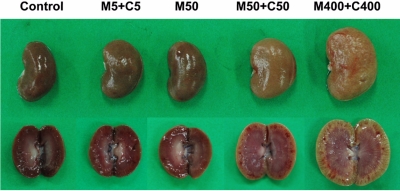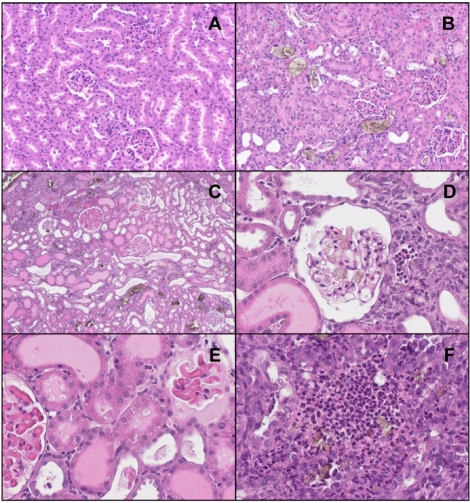Lab Anim Res.
2011 Mar;27(1):25-28. 10.5625/lar.2011.27.1.25.
Increased Nephrotoxicity after Combined Administration of Melamine and Cyanuric Acid in Rats
- Affiliations
-
- 1College of Veterinary Medicine and Research Institute of Veterinary Medicine, Chungbuk National University, Cheongju, Republic of Korea. solar93@cbu.ac.kr
- 2Division of Marine Molecular Biotechnology, Gangneung-Wonju National University, Gangneung, Republic of Korea.
- 3College of Veterinary Medicine, Chonnam National University, Gwangju, Republic of Korea.
- 4College of Veterinary Medicine, Kyungpook National University, Daegu, Republic of Korea.
- KMID: 2391854
- DOI: http://doi.org/10.5625/lar.2011.27.1.25
Abstract
- Renal toxicity by melamine in combination with cyanuric acid (1:1) was investigated. Male rats were orally administered melamine plus cyanuric acid (5, 50 or 400 mg/kg each) for 3 days. In contrast to a negligible effect by melamine alone (50 mg/kg, a no-observed-adverse-effect-level: NOAEL), co-administration with cyanuric acid markedly increased the concentrations of blood urea nitrogen and creatinine, as well as kidney weight. A high dose (400 mg/kg) of melamine plus cyanuric acid induced more severe kidney toxicity. The increased blood parameters for kidney toxicity and organ weight lasted longer than 4 days. Combined treatment with melamine and cyanuric acid (50-400 mg/kg each) resulted in many gold-brown crystals and toxic lesions in renal tubules, which were not observed in animals treated with melamine alone (50 mg/kg). These results indicate that only a 3-day exposure to melamine in combination with cyanuric acid causes severe renal damage, even at a NOAEL for melamine found in a 13-week toxicity study. Therefore, it is suggested that the tolerable daily intake or regulatory/management levels of melamine need to be re-considered for cases of co-exposure with cyanuric acid.
Keyword
MeSH Terms
Figure
Reference
-
1. Ames MM, Powis G, Kovach JS, Eagan RT. Disposition and metabolism of pentamethylmelamine and hexamethylmelamine in rabbits and humans. Cancer Res. 1979; 39:5016–5021. PMID: 115586.2. Brown CA, Jeong KS, Poppenga RH, Puschner B, Miller DM, Ellis AE, Kang KI, Sum S, Cistola AM, Brown SA. Outbreaks of renal failure associated with melamine and cyanuric acid in dogs and cats in 2004 and 2007. J Vet Diagn Invest. 2007; 19:525–531. PMID: 17823396.
Article3. Cook AM, Beilstein P, Grossenbacher H, Hütter R. Ring cleavage and degradative pathway of cyanuric acid in bacteria. Biochem J. 1985; 231:25–30. PMID: 3904735.
Article4. Dobson RLM, Motlagh S, Quijano M, Cambron RT, Baker TR, Pullen AM, Regg BT, Bigalow-Kern AS, Vennard T, Fix A, Reimschussel R, Overmann G, Shan Y, Daston GP. Identification and characterization of toxicity of contaminants in pet food leading to an outbreak of renal toxicity in cats and dogs. Toxicol Sci. 2008; 106:251–262. PMID: 18689873.
Article5. Hammond BG, Barbee SJ, Inoue T, Ishida N, Levinskas GJ, Stevens MW, Wheeler AG, Cascieri T. A review of toxicology studies on cyanurate and its chlorinated derivatives. Environ Health Perspect. 1986; 69:287–292. PMID: 3545805.
Article6. Ingelfinger JR. Melamine and the global implications of food contamination. N Engl J Med. 2008; 359:2745–2748. PMID: 19109571.
Article7. Kitchen DN, Carlton WW, Tuite J. Ochratoxin A and citrinin induced nephrosis in Beagle dogs. II. Pathology. Vet Pathol. 1977; 14:261–272. PMID: 883089.
Article8. Kogika MM, Hagiwara MK, Mirandola RM. Experimental citrinin nephrotoxicosis in dogs: renal function evaluation. Vet Hum Toxicol. 1993; 35:136–140. PMID: 8470356.9. Screening information data set for melamine, CAS No. 108-78-1. OECD. 1998. http://www.chem.unep.ch/irptc/sids/OECDSIDS/108781.pdf.10. Screening information data set for isocyanuric acid, CAS No. 108-80-5. OECD. 1999. http://www.chem.unep.ch/irptc/sids/OECDSIDS/108805.pdf.11. Puschner B, Poppenga RH, Lowenstine LJ, Filigenzi MS, Pesavento PA. Assessment of melamine and cyanuric acid toxicity in cats. J Vet Diagn Invest. 2007; 19:616–624. PMID: 17998549.
Article12. Expert meeting to review toxicological aspects of melamine and cyanuric acid. Executive summary. WHO. 2008. http://www.who.int/foodsafety/fsmanagement/ExecSummarymelamine.pdf.
- Full Text Links
- Actions
-
Cited
- CITED
-
- Close
- Share
- Similar articles
-
- Synergistic effect of melamine in combination with cyanuric acid on urinary tract toxicity in rats
- Mini-review; Melamine-related Urinary Stone Disease
- The Expressions of iNOS and the Effects of iNOS Inhibitor in the Rats of Cisplatin Induced Nephrotoxicity
- A Case of Occupational Allergic Contact Dermatitis to Melamine - Formaldehyde Resin
- In vitro toxicity of melamine against Tetrahymena pyriformis cells



